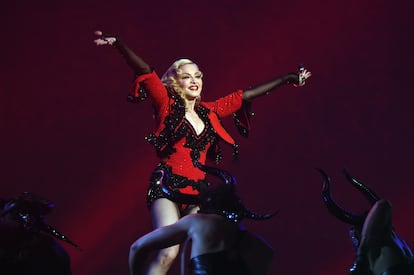How Madonna became the queen of pop: four key moments in her career
As iconic as controversial and innovative, at the age of 65, Madonna undeniably remains as one of the greatest artists in recent music history. These are the moments that defined her career and pop culture

There is no other “Queen of Pop” other than Madonna. The American artist has left an indelible mark on the music industry and popular culture. As she’s turning 65 and getting ready to embark on her last tour, we take a look at some of the pivotal moments that have shaped her legacy and elevated her to being one of the most influential artists of all time,
‘Papa Don’t Preach’
Before the release of her third album, True Blue (1986), Madonna was already a popular figure known for causing controversy with her image and themes. However, Papa Don’t Preach would mark an important step as an artist, being the first time she “redefined” her image, while creating controversy with her lyrics and visuals.
The lyrics, written by Brian Elliot with few additions by Madonna, are from the perspective of a young woman who gets pregnant with her boyfriend, who says he’s going to marry her, and begs her father that he accepts it. The singer said she was interested in the song because it fit with her “own personal zeitgeist,” influenced by her Catholic and conservative upbringing.
The music video, which presents the song’s story with Madonna playing the young girl and actor Danny Aiello portraying the father, ignited the abortion debate in America. While some organizations and members of the government thought the song invited youth to avoid birth control, others saw it as an anti-abortion song. However, that was not Madonna’s stance, who, according to her publicist Liz Rosenberg, has a philosophy that “people can think what they want to think.”
Today, the video is considered one of the best of her career, and marked the first time she explored the music video creation beyond its promotional potential. After that, her videos either told the story the song told or were an attempt to push herself creatively, creating more discussions along the way.
‘Sex’
October 1992 marked a new era for Madonna. She released her fifth studio album, Erotica, and a coffee table book titled Sex. The book consisted entirely of sexually provocative and explicit images featuring her and several collaborators, photographed by Steven Meisel. The book caused enormous controversy and received strong negative reaction from the media and the public. It particularly caused backlash from conservative, feminist and anti-porn groups, with some considering the content hardcore pornography.
Sex generated all kinds of reactions. Most of the media criticized the work, with some calling it childish, not revolutionary, derivative and even funny in a negative way. Some also suggested that the artist’s goal was to “shock” the audiences and that the book didn’t help her earlier empowering image. The negative press even affected the sales of Erorica, with some retailers boycotting the album or the book. Despite the controversy, Madonna remained steadfast in her artistic choices and defended her work as an exploration of sexuality, freedom, and self-expression. The singer continued to explore these themes in her music, performances and in cinema, starring in Uli Edel’s Body of Evidence (1993), and Abel Ferrara’s Dangerous Game (1993).
Despite the backlash, later criticism has been more positive, particularly in the academic community. There is a field called Madonna Studies, which is the study of the work and life of the singer and her impact in popular culture. The themes of sexuality are of interest because of how it influenced today’s society and culture. Madonna could be credited for making BDSM and sexual exploration mainstream, which paved the way for more open discussions about such subjects. And, although she hasn’t allowed a republication of Sex (making it a Holy Grail for collectors), she is still unapologetic about that era.
‘Evita’
Madonna’s road to star in Alan Parker’s adaptation of Evita started in 1986, eight years before production started. Paramount was starting to develop the project for film when the singer visited producer Robert Stigwood, producer of the West End adaptation dressed in a gown and a 1940s hairdo, expressing her interest in portraying the historical figure. After Alan Parker took the helm as director, the singer sent him a four-page letter detailing her deep passion for the role and her determination to bring Eva Perón’s story to life on the big screen. In her letter, Madonna highlighted her connection to the character’s journey — from a young girl with dreams of stardom to a powerful and controversial political figure. She emphasized how the story resonated with her own experiences of navigating fame, adversity, and the public’s often conflicting perceptions. Parker agreed and developed the movie close to her.
Although the movie generated mixed reviews, most critics praised Madonna’s performance, and she won the Golden Globe Award for Best Actress in a Motion Picture Musical or Comedy.
It’s worth noting that Madonna was pregnant during filming, and was worried that would affect her performance. Biographer Mary Cross would later write about the aftermath: “Now 38 years old, Madonna had at last triumphed on screen and achieved her dream of having a child, both in the same year. She had reached another turning point in her career, reinventing herself and her image with the public.”
‘American Life’ and ‘Confessions on a Dance Floor’
Madonna started the 21st century with Music, her eight studio album in 2000, produced by electronic dance songwriter Mirwais Ahmadzaï. Acclaimed by critics and nominated for five Grammys, the album defined the electronica sound for the era and, again, showcased her constant growth and learning as an artist, proving why she was nicknamed the “Queen of Pop.”
However, it was with her next two albums, American Life and Confessions on a Dance Floor that she widened her audience, finding her place with the new generations. Both show two different faces of the artist and highlight her ability to remain relevant and influential.
American Life marked a significant shift in Madonna’s artistic direction. Released in 2003, the album delved into introspective themes, addressing societal issues, the emptiness of fame, and personal struggles. These themes were all inspired by the aftermath of the September 11 attacks. While not as commercially successful as some of her earlier albums, American Life today is considered one of her more mature works, with Madonna evolving as a writer and as observant of life and brought her a new audience that would grow even larger with her next album.
Released in 2005, Confessions on a Dance Floor saw Madonna embracing her dance-pop roots with renewed energy. The concept album, which musically was more a continuation of Music than American Life, included a list of high-energy tracks, seamlessly mixed together to create a continuous dance experience. Singles like Hung Up (one of her most popular songs today) and Sorry became worldwide hits, appealing to both longtime fans and new audiences. The album’s success cemented her as a timeless dance music icon.
These two albums showcase Madonna’s remarkable adaptability and her knack for reinvention. American Life and Confessions on a Dance Floor demonstrated that Madonna was not ready to stop; instead, she continued to evolve her sound and message to remain relevant in the ever-changing music landscape. With these albums, Madonna solidified her status as a pop culture icon, inspiring and influencing both her loyal fanbase and a new generation of listeners.
Sign up for our weekly newsletter to get more English-language news coverage from EL PAÍS USA Edition
Tu suscripción se está usando en otro dispositivo
¿Quieres añadir otro usuario a tu suscripción?
Si continúas leyendo en este dispositivo, no se podrá leer en el otro.
FlechaTu suscripción se está usando en otro dispositivo y solo puedes acceder a EL PAÍS desde un dispositivo a la vez.
Si quieres compartir tu cuenta, cambia tu suscripción a la modalidad Premium, así podrás añadir otro usuario. Cada uno accederá con su propia cuenta de email, lo que os permitirá personalizar vuestra experiencia en EL PAÍS.
¿Tienes una suscripción de empresa? Accede aquí para contratar más cuentas.
En el caso de no saber quién está usando tu cuenta, te recomendamos cambiar tu contraseña aquí.
Si decides continuar compartiendo tu cuenta, este mensaje se mostrará en tu dispositivo y en el de la otra persona que está usando tu cuenta de forma indefinida, afectando a tu experiencia de lectura. Puedes consultar aquí los términos y condiciones de la suscripción digital.
More information
Archived In
Últimas noticias
Most viewed
- David King, chemist: ‘There are scientists studying how to cool the planet; nobody should stop these experiments from happening’
- Reinhard Genzel, Nobel laureate in physics: ‘One-minute videos will never give you the truth’
- Mexico completes its trade shift with the entry into force of tariffs on China and countries without trade agreements
- Oona Chaplin: ‘I told James Cameron that I was living in a treehouse and starting a permaculture project with a friend’
- Sinaloa Cartel war is taking its toll on Los Chapitos











































